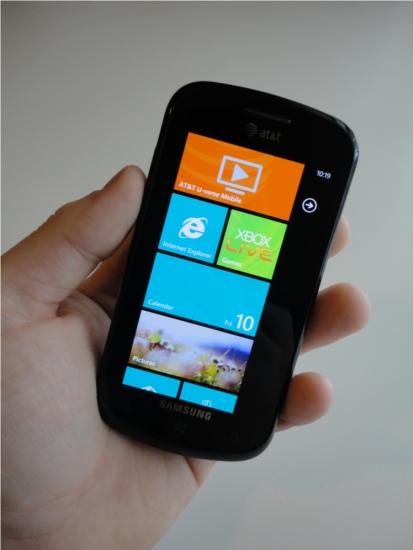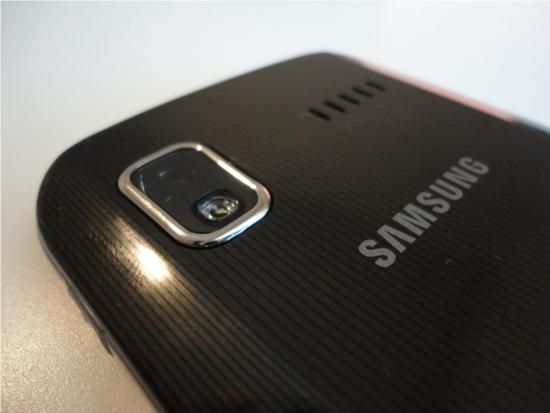
Inside the Samsung Focus box, you will find nothing extraordinary. Instantly, you are greeted with your user manual and quick start guide, and underneath, you will find the device itself. Below some pull-out sections, you will come to the earbuds, AC USB adapter and USB data transfer cable, which is also used for charging.
If you didn't already know what the Focus looked like, you would probably assume it's just another Android device. I mean, they are a dime a dozen these days, right? When you pick it up for the first time, you will more than likely be taken aback at how light it is. Weighing in at 4.07 ounces, it's just over 0.4 ounces lighter than the Captivate. That doesn't really seem like much, but it's definitely a noticeable difference. On the face of the device you will find the speaker at the top, below is the beautiful 4.0-inch Super AMOLED display, and at the bottom are the three capacitive buttons; back, home, and search. One the top edge is the microUSB port, neatly hidden behind a plastic sliding-cover, and the 3.5 mm headphone jack. On the right edge, near the top is power button and a little closer to the bottom, ending the chrome band is the dedicated camera key. On the bottom of the device is the microphone, and the left side holds the volume rocker. The 5.0-megapixel camera, LED flash, and loud speaker are all located on the upper portion of the back of the device.
While I have no doubt that the device is sturdy – the build quality is great – but the overuse of plastic really takes away from the beauty of the device and makes it feel cheap. That said, it's still a beautifully designed piece of hardware and the display is breathtaking. I just wish Samsung would have used at least some metal accents or trim.
The first thing you will notice about the Focus is the display. Just like all of Samsung's Galaxy S devices, the Focus sports a Super AMOLED display that is known for it's high contrasts, near true blacks, and being very bright and more effective than others in sunlight. Samsung's intent was to make the Focus's display appear larger than it is, and they executed this quite well. What do I mean? The edges of the display are lost in the device because they have matched the black plastic on the face of the device with that of the blacks displayed with the SAMOLED display. It's genius to say the least. The contrast of the display really makes the colors pop and the tiles of Windows Phone 7 stick out, and while I'm not partial to a Super AMOLED display on Android, I think it looks absolutely brilliant on Windows Phone 7. They accent each other very well.
The processor in the Focus is a 1 GHz Snapdragon processor, and I'm pleased to say it performs as expected. In basic use of the device, I noticed no lag, but if you read my review on the HD7, you already know that in rotating the screen, the Focus can take up to one second longer than the HD7 to rotate. However, I noticed that if you rotate 180 degrees as opposed to 90, the Focus rotates faster than the HD7. I find it a little odd and don't really know what to say about it. For all I know, it could just be the accelerometer, not the processor. Again, in saying I experienced no lag that is in basic use of the phone, I'm excluding third-party applications because they definitely lag. That is not due to the phone or it's capabilities, that is a score that Microsoft is going to have to settle with the developers. Load times of third-party applications range anywhere from 10-30 seconds. It isn't just the first time you launch the application either, it is each and every time.
The internal storage on the Focus is 8 GB, which seems kind of like a drag at first, but the Focus is one of the only Windows Phone 7 devices that has a microSD card slot. Microsoft strongly discouraged microSD cards with their operating system, but Samsung and AT&T blatantly ignored them and ran with it anyway. This led to SD card troubles at the device's launch, but it has all been resolved now. The Focus also sports 512 MB of RAM and 1 GB ROM. Needless to say, you should be fine in terms of memory on the Focus, it's on par with most devices out there, if not better.
The call quality on the Focus was great, probably better than most of the devices I have laying around. I know for a fact that it sounds better than my myTouch 4G. But there were no issues with me hearing anyone on the other end or with them hearing me. The speaker on the back of the device allows for a decently loud speakerphone conversation, but there are other Windows Phone 7 devices on AT&T if you're looking for a louder speaker. Signal quality was fine too. It was about the same as my Nexus One. I generally get 2-3 bars in my apartment on AT&T, no difference with the Focus.

Typing on the Focus was decent. In comparison with the HD7, the Focus doesn't even come close, but it's easier than typing on most smaller Android devices, thanks to the larger screen. One thing I did notice on the Focus is how great the auto-correction works. I could type just about as fast as I wanted to and I didn't have to worry about going back and fixing a lot of crazy mistakes, it caught most of them. I didn't notice this on the HD7 because with the larger keyboard, I made a lot less mistakes.
One of the higher points of the Focus is the camera. Even at 5 megapixels, it's one of the better phones I have used to take pictures with. The LED flash makes for great pictures in low-light settings and the camera does just fine on its own with sufficient lighting. The auto-focus was a bit slow to actually focus, but I never had a problem with it not being able to focus or having to re-take a picture due to poor focusing, like on many phones. It even seemed to withstand my shaky hands whereas most phones take blurred pictures if you shake the slightest bit. Video quality was pretty good on the Focus as well. It records at 720p, but like the HD7 and all Windows Phones I presume, you will have to set it to 720p each and every time you want to record in HD. Otherwise, it defaults to VGA.
Battery life is definitely nothing to get excited about. Even at 1500 mAh, the battery seemed to drain pretty quickly for me, which is surprising. It hasn't been used too terribly much and signal doesn't vary a whole lot in my apartment. Side-by-side with the HD7, which has a 1230 mAh battery, the Focus did drain a little faster. Of course, it could be a number of things. The Focus has been going (mainly on standby) for just about two days now, but it's barely scraping by. I don't think it should be a problem being able to make it through an entire day with moderate usage, but plan on charging this bad boy nightly.
Browsing the Internet with a Windows Phone 7 device is a pleasure, as always. Pages load quickly, they render well, and panning and zooming in a breeze. Windows Phone's browser does lack quite a few features though. You can long press and open links in new windows or share them, but the options are thin. With updates, I'm sure Microsoft will polish off their product well and the browser will become more well-rounded and even more pleasing to use.
With the Focus, I found the capacitive buttons below the screen were oddly placed. To me, it would have made more sense to place the buttons directly below the display, rather than branding Samsung on the face of the device, which they're widely known for. Rather than hitting the back button when I wanted to the previous page, I found myself constantly pressing on the word “Samsung.” If anything, they should have at least had the buttons light up. Although, that would just suck up more juice and hurt the already mediocre battery life. On top of their poor placement, they seemed unresponsive at times. I would press on the button and I would get no haptic feedback. Two or three presses later, the phone would finally react. This only happened once or twice, but it didn't go without noticing.
Stacking the Focus up against its counterparts, whether on paper or in action, holds its own. It's size and the materials it's made of may not be as charming as the HD7, and the battery life may not be the best out there, but the Focus has some unique benefits of its own. Whether it's the beautiful display that becomes lost in the face of the device or the exceptional camera that wins you over, I'm sure you will be pleased with your decision. For $199.99 with a two-year agreement, the Focus is sure to make any new smartphone users, or even return customers, happy.
What's Good: Lightweight with good build quality; has microSD card slot, can capture some great pictures, quick with its Snapdragon processor; extremely crisp and colorful Super AMOLED display.
What's Bad: Mediocre battery life; very cheap, “plasticy” feel; some lag from time to time (third-party apps); Windows Phone 7 still has some bugs; blemishes very easily.
The Verdict: The Samsung Focus is a great device. The build quality is great, but Samsung tends to use more plastic than necessary and it really takes away from the great engineering that's going on under the hood. It has one of the better cameras I've used on a phone and it delivers a great Windows Phone 7 experience. For $199.99 with a two-year agreement on AT&T, the Samsung Focus is a great choice for many.